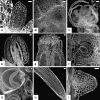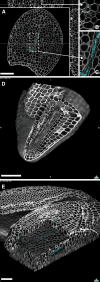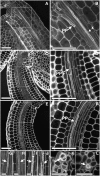High-resolution whole-mount imaging of three-dimensional tissue organization and gene expression enables the study of Phloem development and structure in Arabidopsis
- PMID: 18523061
- PMCID: PMC2483377
- DOI: 10.1105/tpc.107.056069
High-resolution whole-mount imaging of three-dimensional tissue organization and gene expression enables the study of Phloem development and structure in Arabidopsis
Abstract
Currently, examination of the cellular structure of plant organs and the gene expression therein largely relies on the production of tissue sections. Here, we present a staining technique that can be used to image entire plant organs using confocal laser scanning microscopy. This technique produces high-resolution images that allow three-dimensional reconstruction of the cellular organization of plant organs. Importantly, three-dimensional domains of gene expression can be analyzed with single-cell precision. We used this technique for a detailed examination of phloem cells in the wild type and mutants. We were also able to recognize phloem sieve elements and their differentiation state in any tissue type and visualize the structure of sieve plates. We show that in the altered phloem development mutant, a hybrid cell type with phloem and xylem characteristics develops from initially normally differentiated protophloem cells. The simplicity of sieve element data collection allows for the statistical analysis of structural parameters of sieve plates, essential for the calculation of phloem conductivity. Taken together, this technique significantly improves the speed and accuracy of the investigation of plant growth and development.
Figures





Comment in
-
High-resolution three-dimensional imaging of plant tissues.Plant Cell. 2008 Jun;20(6):1423. doi: 10.1105/tpc.108.200610. Epub 2008 Jun 3. Plant Cell. 2008. PMID: 18523059 Free PMC article. No abstract available.
-
Looking deeper: whole-mount confocal imaging of plant tissue for the accurate study of inner tissue layers.Plant Signal Behav. 2009 Feb;4(2):151-2. doi: 10.4161/psb.4.2.7683. Plant Signal Behav. 2009. PMID: 19649197 Free PMC article.
References
-
- Bauby, H., Divol, F., Truernit, E., Grandjean, O., and Palauqui, J.C. (2007). Protophloem differentiation in early Arabidopsis thaliana development. Plant Cell Physiol. 48 97–109. - PubMed
-
- Bechtold, N., Ellis, J., and Pelletier, G. (1993). In planta Agrobacterium mediated gene transfer by infiltration of adult Arabidopsis thaliana plants. C. R. Acad. Sci. III, Sci. Vie Life Sci. 316 1194–1199.
-
- Birnbaum, K., Shasha, D.E., Wang, J.Y., Jung, J.W., Lambert, G.M., Galbraith, D.W., and Benfey, P.N. (2003). A gene expression map of the Arabidopsis root. Science 302 1956–1960. - PubMed
-
- Bonke, M., Thitamadee, S., Mahonen, A.P., Hauser, M.T., and Helariutta, Y. (2003). APL regulates vascular tissue identity in Arabidopsis. Nature 426 181–186. - PubMed
-
- Bougourd, S., Marrison, J., and Haseloff, J. (2000). Technical advance: An aniline blue staining procedure for confocal microscopy and 3D imaging of normal and perturbed cellular phenotypes in mature Arabidopsis embryos. Plant J. 24 543–550. - PubMed
Publication types
MeSH terms
LinkOut - more resources
Full Text Sources
Other Literature Sources
Molecular Biology Databases

